Approximately 3,000 of the approximately 40,000 species of spiders worldwide are found in North America. There are a lot of eight-legged critters in the world, therefore house spiders will inevitably appear in your home occasionally. Additionally, the degree of concern varies among species, which is why it’s critical to learn how to recognize the creatures.
The article below will help you learn about 10 species of grey house spiders with pictures and how to identify them.
Different Types of Grey House Spiders
Grey House Spider
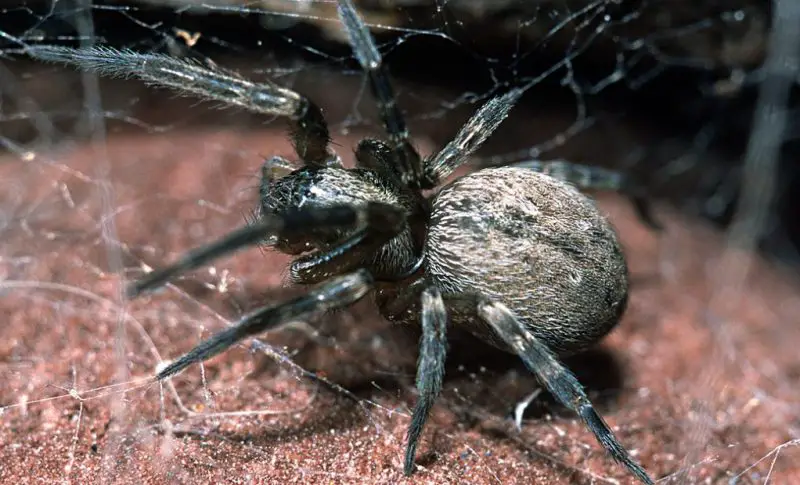
The Grey House Spider (Badumna longinqua) is a familiar resident in households, representing one of the most prevalent gray spiders that coexist with humans and engage in the art of web-spinning. Easily identified by its gray and black-haired body, featuring sporadic white hairs along its abdomen, this arachnid presents a distinctive appearance.
Mottled shades of gray and black adorn the spider’s head, while its legs boast a dominant brown hue. As a larger indoor spider that skillfully constructs webs, the Grey House Spider has gained a reputation for its adeptness in hunting both small and large insects. With a menu that includes various species of ants, flies, and even cicadas, these spiders play a crucial role in maintaining the balance of their ecosystem.
Encounters with Grey House Spiders are common in household nooks such as basements, garages, and corners, where they diligently spin their intricate webs. The female spiders, in particular, take charge of web-building in these secluded spaces. Interestingly, the emerging spiderlings mirror the appearance of their adult counterparts but in a more diminutive form.
Unlike some spiders that live communally, young Grey House Spiders prefer a solitary lifestyle, eventually venturing out on their own. Notably, these newly-emerged spiders employ fascinating techniques like ballooning to navigate away from the influence of the wind, showcasing nature’s ingenious strategies for dispersal.
Grey Cross Spider
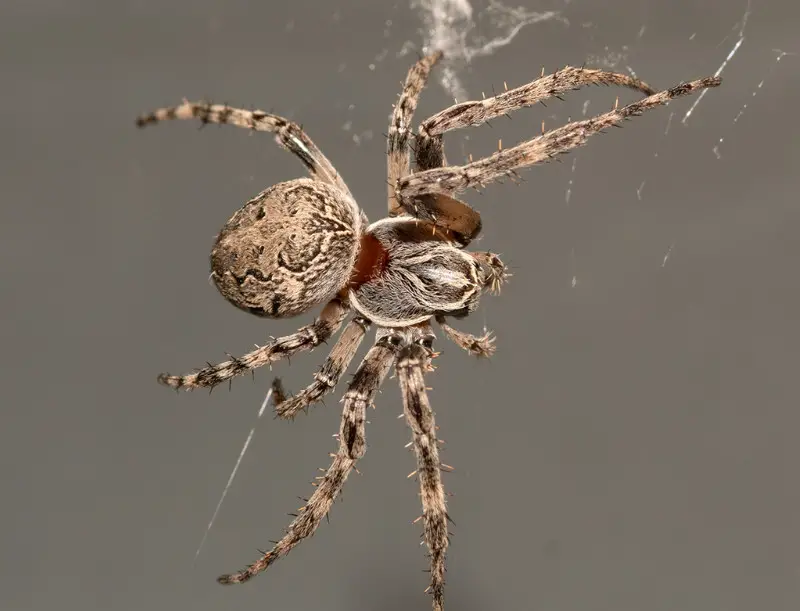
The Grey Cross Spider (Larinioides sclopetarius) is a distinctive arachnid species found across Europe, as well as on both the East and West Coasts of the United States, along with the Southern States. Notable for their mottled gray coloring, these spiders exhibit variations in appearance between males and females.
Male Grey Cross Spiders boast a dark gray coloration on a base of lighter gray, extending to their heads and legs. In contrast, the larger females display a blend of red and brown hues, and they can be up to twice the size of their male counterparts. These spiders have adapted to living in close proximity to human settlements, frequently inhabiting homes, public urban areas, and various abandoned structures.
The Grey Cross Spider’s affinity for light sources becomes evident during nighttime, particularly in summer. They are often spotted near public lights that attract flies and mosquitoes, creating an ideal hunting ground for these arachnids. Females, distinguished by their larger size, are known for their web-building skills, while males tend to be found nearby, exhibiting territorial behaviors.
Interestingly, the interactions between male and female Grey Cross Spiders involve a complex dynamic. Males may attempt to navigate the female’s web for cohabitation and mating, but not all are accepted. Aggressive behavior from females towards males is a common occurrence, highlighting the territorial nature of the males.
Research indicates that even juvenile Grey Cross Spiders engage in web-building, though their creations are smaller in scale. These smaller webs serve as effective traps for catching diminutive prey such as ants. Juveniles may face challenges in maturing when food sources are scarce.
As autumn draws to a close, the Grey Cross Spider faces the inevitable cycle of life. Cold weather signals the end of their lifespan, marking a natural conclusion to their existence in the seasonal web of nature.
Gray Wall Jumping Spider
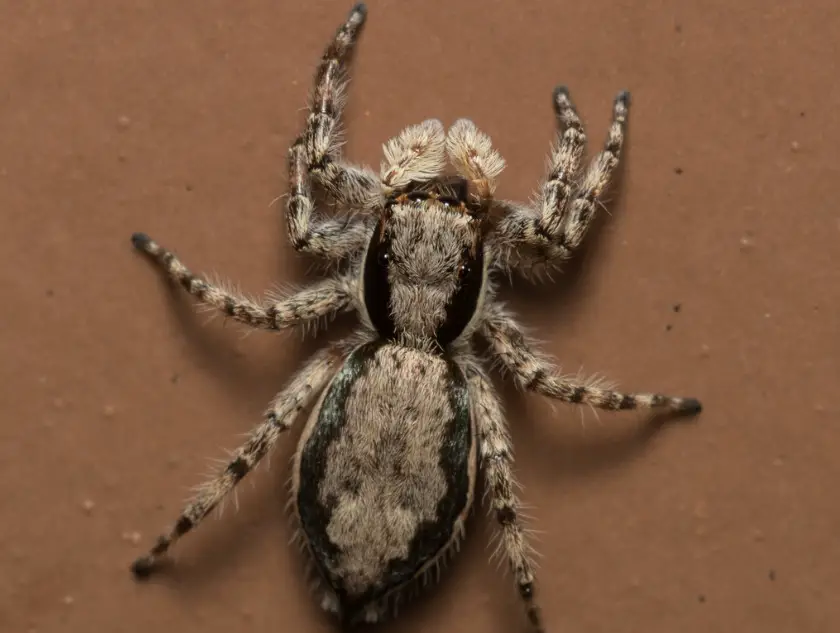
The Gray Wall Jumping Spider (Menemerus bivittatus) is an arachnid commonly encountered in and around homes. Unlike many of its counterparts, this species doesn’t construct intricate webs to capture prey but rather relies on its agility and hunting prowess.
Distinguishing between male and female Gray Wall Jumping Spiders is relatively simple. Males typically showcase a predominantly gray coloration with prominent black stripes adorning their bodies. Meanwhile, females lean towards a cream or tan hue. The male spiders further exhibit a striking combination of gray and black banding on their legs, adding to their distinctive appearance.
With a maximum size of approximately 9mm, these spiders may seem diminutive, but their keen predatory instincts make them formidable hunters. Their hairy exterior contributes to a unique texture, making them easily recognizable.
One can often spot these spiders on the outer walls of homes, where they actively pursue insects for sustenance. The gray coloring of their bodies serves as a natural camouflage, allowing them to blend seamlessly with tree bark. In addition to homes, Gray Wall Jumping Spiders can also be found on trees, showcasing their adaptability to various environments.
Originally native to Africa, these spiders have expanded their habitat and can now be found in parts of the United States, such as Florida and Texas, where they were introduced. The Gray Wall Jumping Spider’s ability to thrive in diverse surroundings, coupled with its outstanding features, makes it a noteworthy inhabitant of our surroundings.
Grey Huntsman
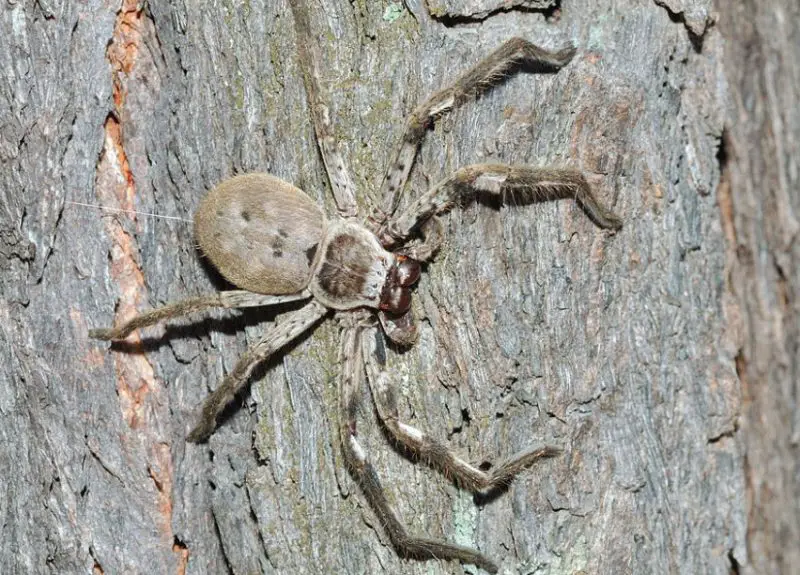
The Grey Huntsman (Isopeda villosa), native to Australia, stands out as an arachnid with its distinct gray base color. This species exhibits a nearly uniform gray hue across both its body and legs, showcasing variations in shades from light to darker grays. Notably, a couple of black spots adorn the area just behind the head, adding to the unique features of these spiders.
Unlike their web-spinning counterparts, Grey Huntsman spiders are active hunters, eschewing the construction of intricate webs. They favor habitats such as trees, hollow wood, rocks, and crevices, where they display their remarkable hunting prowess. This species preys on a variety of insects, with larger specimens like crickets on their menu. However, the bulk of their diet consists of small bugs residing in damp places, such as woodlice.
Although Grey Huntsmen are venomous, their venom poses no threat to humans. While bites from these spiders have been reported, they are generally non-aggressive and only bite in response to rough handling. The bites, while possibly discomforting, do not result in any significant health issues for humans.
Grayish Jumping Spider
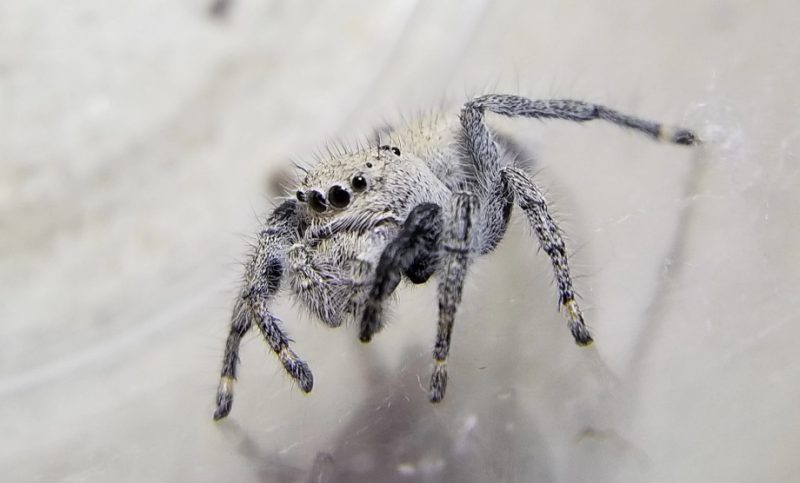
The Grayish Jumping Spider (Phidippus princeps) is a remarkable arachnid known for its agile hunting technique. This species stands out not only for its jumping ability but also for the distinctive coloration that sets males and females apart.
Females of the Grayish Jumping Spider exhibit a blend of gray mottling with subtle brown nuances, adorning both their bodies and legs. In contrast, the males have a sleek black exterior with striking orange-brown markings on their abdomen.
As suggested by its name, the Grayish Jumping Spider is an adept hunter that relies on its jumping prowess to capture prey. This includes small insects and even other spiders. The secret to its impressive jumping ability lies in its robust legs, which function like powerful springs, propelling the spider forward with remarkable speed and precision.
What sets this jumping spider apart is its exceptional vision, a crucial asset for its hunting strategy. With keen eyesight, these spiders skillfully spot and track their prey, ensuring a successful leap and capture. The combination of remarkable jumping skills and acute vision makes the Grayish Jumping Spider a formidable predator in the world of arachnids.
Half-Edged Wall Jumping Spider
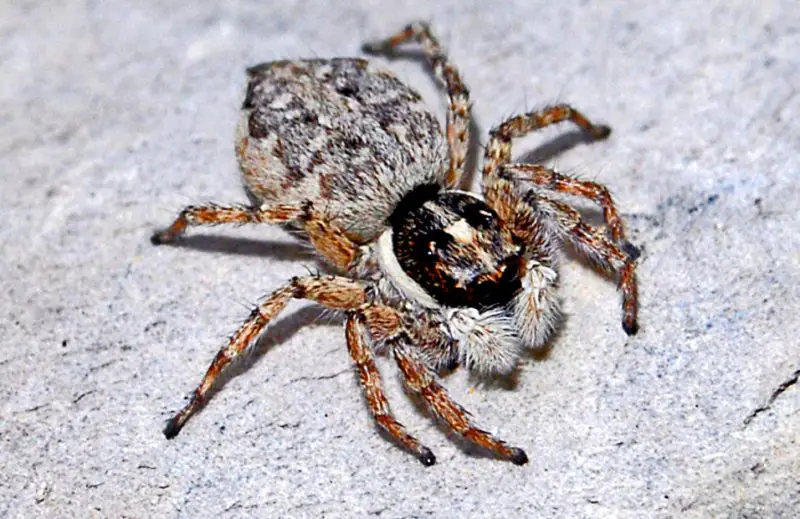
The Half-Edged Wall Jumping Spider (Menemerus semilimbatus) is an arachnid, particularly notable for its close association with human settlements. Unlike some spiders that prefer the seclusion of natural environments, these gray spiders have adapted to thrive in proximity to human habitats, making them a common sight in urban areas, suburban neighborhoods, gardens, and even indoors.
Characterized by a distinctly hairy body, the Half-Edged Wall Jumping Spider showcases an abdomen with a blend of dark and light gray mottling. The legs of this spider further contribute to its unique appearance, displaying a pattern of black and gray.
Despite its diminutive size, reaching a maximum of 0.3 inches, this spider can be frequently observed on the outer walls of homes. One peculiar behavior of the Half-Edged Wall Jumping Spider is its tendency to position itself near light bulbs. Here, it patiently waits for insects attracted to the light source, capitalizing on a strategic location to secure its next meal.
Chiricahuan Gray Tarantula
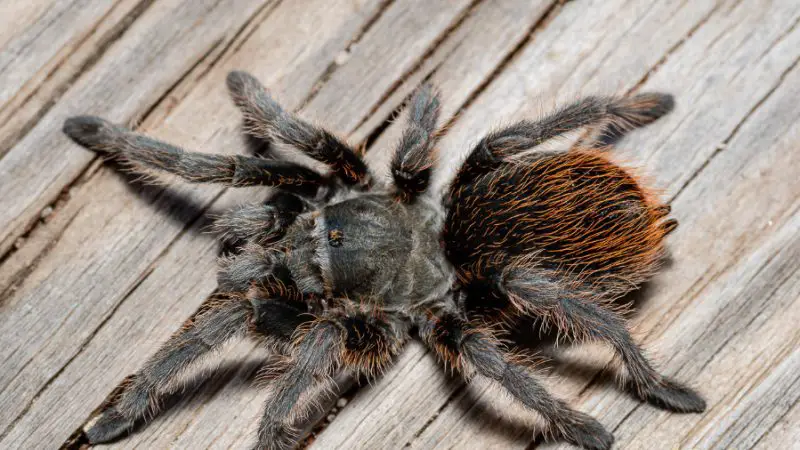
The Chiricahuan Gray Tarantula (Aphonopelma gabeli) is a remarkable arachnid with a distribution encompassing diverse landscapes, including oak woodlands, grassland prairies, and arid areas. Primarily found in Southern Arizona and Mexico, this tarantula species exhibits variations in appearance between genders.
Females of the Chiricahuan Gray Tarantula are distinguished by a sleek black base color, contributing to their strikingly dark appearance. In contrast, males showcase a more intricate palette, featuring shades of gray and black, with additional accents of brown or orange hairs adorning the tips of their abdomens. Even the legs of males exhibit a predominantly gray hue that transitions to black towards the body.
Named after the Chiricahua Mountains, these tarantulas have adapted to a life of concealment, often inhabiting burrows or seeking refuge under wood or rocks. Patient hunters, they rely on their surroundings for flies and other insects to cross their paths before launching a swift attack on their unsuspecting prey.
Native to the mountains of Southern Arizona, the Chiricahuan Gray Tarantula maintains a consistent appearance throughout its life stages. From newly-emerged individuals to mature adults, the species retains its distinct features.
As the newly-emerged tarantulas venture out on their own, they seek uninhabited burrows, establishing their territory in a solitary manner. The Chiricahuan Gray Tarantula, with its unique colorations, habitat preferences, and patient hunting strategy, stands as an example of adaptation in the diverse ecosystems of Arizona and Mexico.
Phidippus Octopunctatus
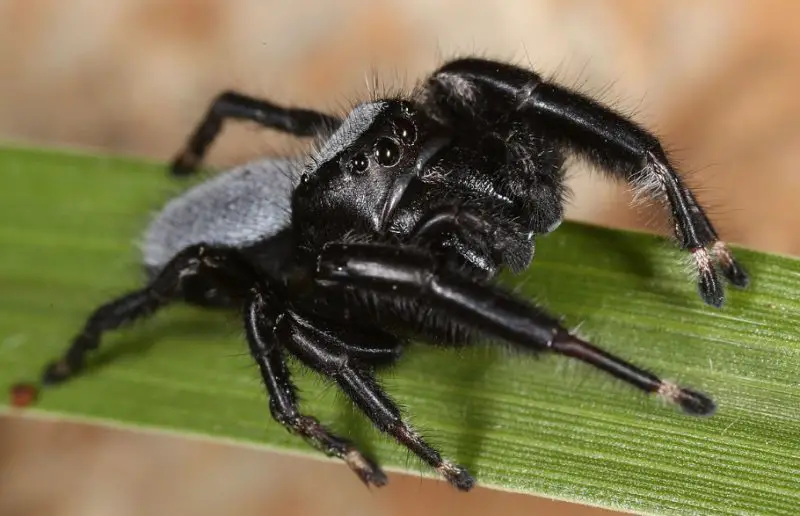
In the extreme southern regions, the Phidippus octopunctatus emerges as a fascinating spider species, characterized by its predominantly gray body and black legs adorned with sporadic gray hairs. This arachnid, approaching a size of nearly 1 inch, exhibits distinct differences between males and females.
Among the notable features distinguishing the sexes are the size variations. Smaller males showcase larger gray areas extending across their bodies, even around the head.
Thriving in arid environments, Phidippus octopunctatus spiders display an affinity for bushes, plants, wildflowers, and trees, where they construct their nests. Their diet is contingent on their location, with common prey including bugs such as grasshoppers. These resourceful hunters also target flies and mosquitoes, particularly in the vicinity of water sources.
During the day, these spiders seek refuge in shaded areas, employing their natural camouflage to remain inconspicuous. This behavioral adaptation aids in both hunting and protection from potential predators.
Despite its adaptability, Phidippus octopunctatus is a short-lived species, remaining active only until the conclusion of the summer season.
People Who Read This Also Read:






